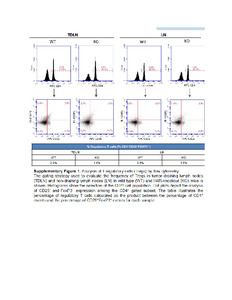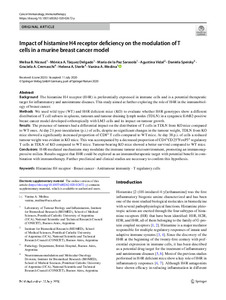Please use this identifier to cite or link to this item:
https://repositorio.uca.edu.ar/handle/123456789/14233| Título: | Impact of histamine H4 receptor deficiency on the modulation of T cells in a murine breast cancer model | Autor: | Nicoud, Melisa Beatriz Táquez Delgado, Mónica Alejandra Sarasola, María de la Paz Vidal, María Agustina Speisky, Daniela Cremaschi, Graciela A. Sterle, Helena Andrea Medina, Vanina Araceli |
Palabras clave: | INMUNIDAD ANTITUMORAL; CANCER DE MAMA; HISTAMINA; CELULAS T | Fecha de publicación: | 2021 | Editorial: | Springer | Cita: | Nicoud, M.B., et al. Impact of histamine H4 receptor deficiency on the modulation of T cells in a murine breast cancer model [en línea]. Cancer Immunology, Immunotherapy. 2021, 70(1) doi:10.1007/s00262-020-02672-y Disponible en: https://repositorio.uca.edu.ar/handle/123456789/14233 | Resumen: | Abstract: Background: The histamine H4 receptor (H4R) is preferentially expressed in immune cells and is a potential therapeutic target for inflammatory and autoimmune diseases. This study aimed at further exploring the role of H4R in the immunobiology of breast cancer. Methods: We used wild type (WT) and H4R deficient mice (KO) to evaluate whether H4R genotypes show a different distribution of T cell subsets in spleens, tumours and tumour draining lymph nodes (TDLN) in a syngeneic ErbB2-positive breast cancer model developed orthotopically with LM3 cells and its impact on tumour growth. Results: The presence of tumours had a differential impact on the distribution of T cells in TDLN from KO mice compared to WT ones. At day 21 post-inoculation (p.i.) of cells, despite no significant changes in the tumour weight, TDLN from KO mice showed a significantly increased proportion of CD8+ T cells compared to WT mice. At day 38 p.i. of cells a reduced tumour weight was evident in KO mice. This was accompanied by a decreased proportion of CD4+CD25+FoxP3+ regulatory T cells in TDLN of KO compared to WT mice. Tumour-bearing KO mice showed a better survival compared to WT mice. Conclusions: H4R-mediated mechanisms may modulate the immune tumour microenvironment, promoting an immunosuppressive milieu. Results suggest that H4R could be explored as an immunotherapeutic target with potential benefit in combination with immunotherapy. Further preclinical and clinical studies are necessary to confirm this hypothesis. | URI: | https://repositorio.uca.edu.ar/handle/123456789/14233 | ISSN: | 0340-7004 (impreso) 1432-0851 (online) |
Disciplina: | MEDICINA | DOI: | 10.1007/s00262-020-02672-y | Derechos: | info:eu-repo/semantics/closedAccess | Fuente: | Cancer Immunology, Immunotherapy. 2021, 70(1) doi:10.1007/s00262-020-02672-y |
| Appears in Collections: | Artículos |
Files in This Item:
| File | Description | Size | Format | Existent users please Login |
|---|---|---|---|---|
| material-complementario.pdf | 301,07 kB | Adobe PDF |  Request a copy | |
| impact-histamine-h4-receptor.pdf | 4,54 MB | Adobe PDF | Request a copy | |
| thumb.pdf | 325,41 kB | Adobe PDF |  View/Open |
Page view(s)
108
checked on Apr 27, 2024
Download(s)
75
checked on Apr 27, 2024
Google ScholarTM
Check
Altmetric
Altmetric
This item is licensed under a Creative Commons License

